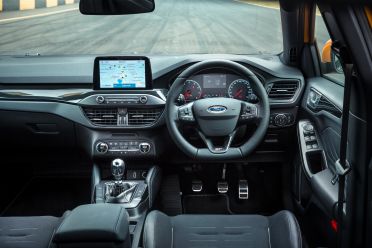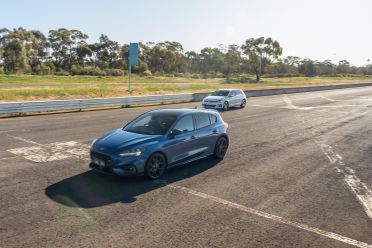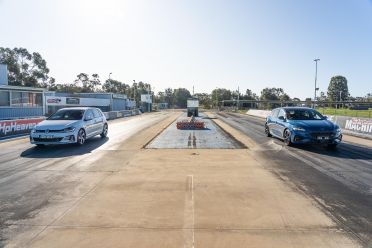We recently tested the all-new Ford Focus ST and fell in love with its animalistic nature. It’s a true weapon of a hot hatch and is built for the driving enthusiast.
We loved the manual Ford Focus ST more than the automatic Ford Focus ST, but both still had performance at their very cores.
So, we thought we would line them both up at the drag strip.
Focus ST automatic v Focus ST manual tests
- Performance specification comparison – what’s the difference between the automatic and the manual?
- Sound test – sure they share the same engine, but do they sound the same?
- Drag race – which is faster, the automatic Ford Focus ST or the manual Ford Focus ST?
- Drag race against the Golf GTI – which is quicker, the faster Ford Focus ST trim or one of the most popular hot hatches in the segment, the Volkswagen Golf GTI?
- Brake test – which car stops quicker? The Ford Focus ST or the Volkswagen Golf GTI?
For perspective and some background, the Ford Focus ST manual and automatic were run in and warm when we did the sound comparison, drag races and brake tests, likewise the Volkswagen Golf GTI.
The surface at the drag strip was unprepped, meaning it’s not an ideally grippy surface, which is why these numbers may seem a little off and finally we don’t deduct the one-foot rollout, the numbers are counted from the moment the car moves until it passes 100km/h or the 1/4 mile marker respectively for each test.
Ford Focus ST engine specifications
Both the manual and automatic Ford Focus ST variants share the same 2.3-litre turbocharged four-cylinder petrol engine that produces 206kW of power and 420Nm of torque.
The manual Focus ST weighs 1506kg (tare mass) and the automatic Focus ST comes in at 1532kg (tare mass), for a total weight difference of 26kg in favour of the manual.
Ford’s seven-speed automatic transmission used in the automatic Focus ST starts off life as an eight-speed automatic transmission, but Ford removes the second gear to reduce weight and also improve gear ratios for performance over economy.
Finally, the biggest difference between these two on the performance front comes at the drag strip where the manual Focus ST is fitted with a launch control feature and a flat shift function, where the automatic doesn’t come with launch control.
Ford claims the 0-100km/h time of the manual Focus ST is 5.7 seconds, while the automatic is 6.0 seconds.
Focus ST performance figures
| Test | Ford Focus ST automatic | Ford Focus ST manual | Volkswagen Golf GTI Performance |
|---|---|---|---|
| 0-100km/h (0-62mph) | 5.8 seconds | 6.4 seconds | 6.3 seconds |
| 1/4 mile | 14.3 seconds at 162.9km/h | 14.7 seconds at 161.8km/h | 14.9 seconds at 161.9km/h |
| 100km/h (62mph) – 0 | 35.3m at 2.6 seconds | – | 39.8m at 2.8 seconds |
Verdict
We definitely weren’t expecting the Focus ST automatic to not only beat Ford’s claimed time, but also beat the manual Focus ST and the Golf GTI.
Our thoughts on the manual – if we had a prepared drag strip surface it would be easier to launch at a higher RPM. We found that using the car’s launch control made it bog down excessively and when we switched off all the traction aids, it would just erupt into wheelspin.
An unprepped drag racing surface will often reduce 0.2 or 0.3 seconds from a 100km/h dash, which then translates over the quarter mile.
We believe that the Golf GTI’s launch control would have allowed it to better hook up on a prepped surface and would have it closer to the Focus ST.
But, for the moment, the Focus ST automatic wins the battle against these three. We’re looking forward to further benchmarking the Focus ST against its peers in the not too distant future!
MORE: Watch more CarExpert Dragparisons
MORE: Ford Focus ST automatic detailed review
MORE: Ford Focus ST manual detailed review







